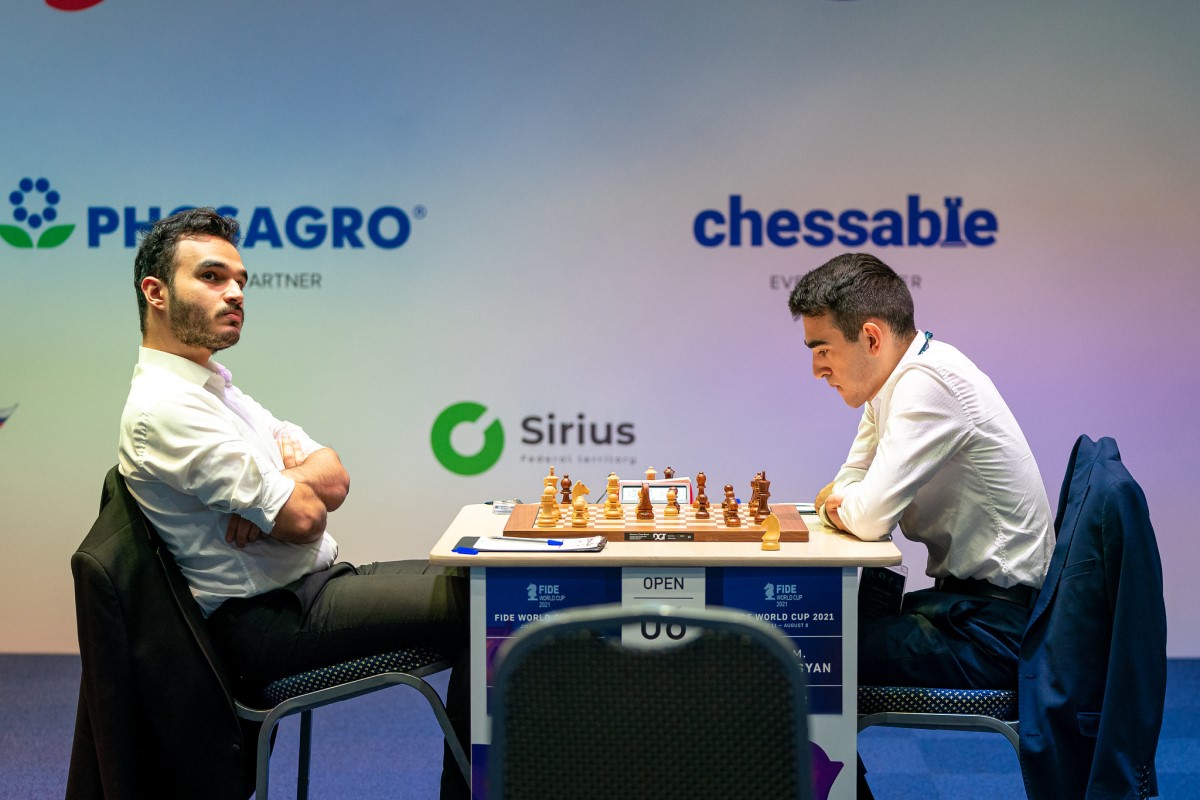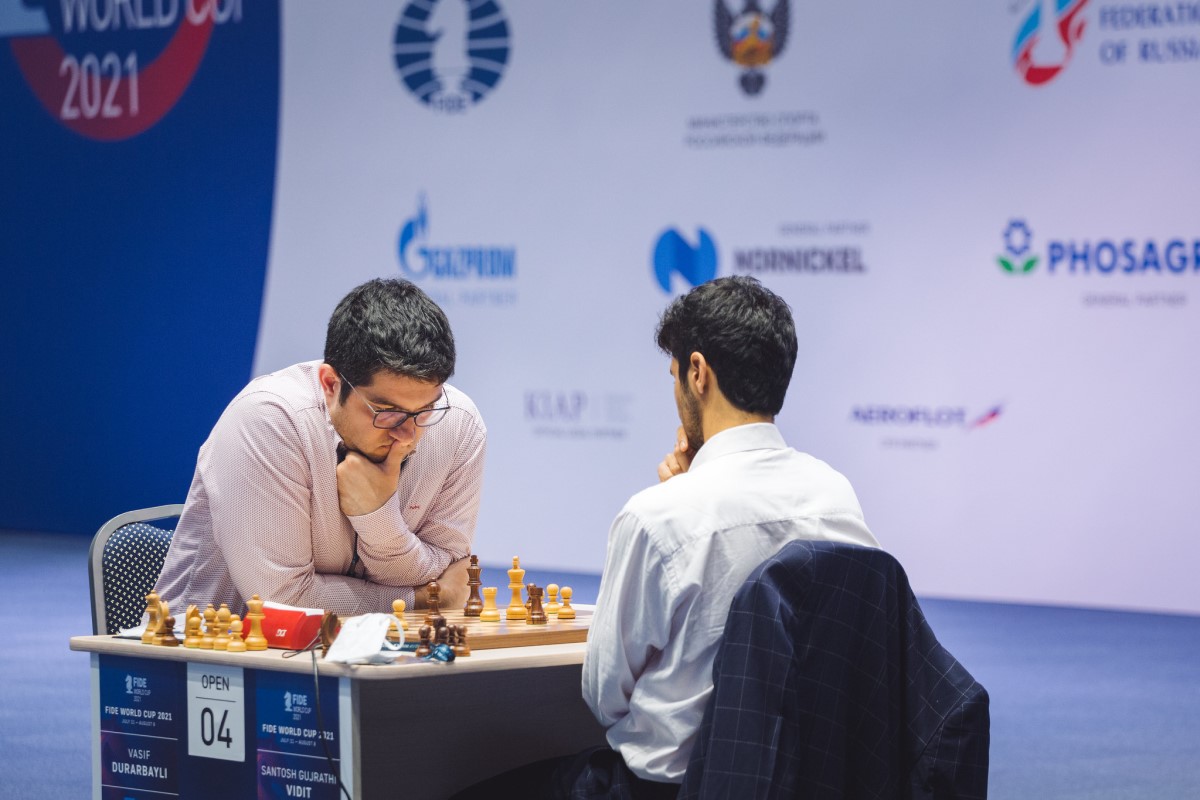Esipenko draws Carlsen comfortably
The participants of the World Cup have been playing chess for a bit over two weeks. For the 16 survivors in the open section, the final objective is already in sight, which means nerves and fatigue will play an increasingly bigger role at the Gazprom Mountain Resort in Sochi.
Day 1 of the round-of-16 saw 7 out of 8 matches finishing drawn, with Andrey Esipenko and Jan-Krzysztof Duda perhaps the happiest of the bunch that ended the day with a half point. Both of them got draws with black, and while Esipenko split a point with world champion Magnus Carlsen, Duda drew an opponent (Alexander Grischuk) against whom he had once lost five times in a row, as he noted in a post-game interview.
 These DVDs are about Understanding Middlegame Strategies. In the first DVD dynamic decisions involving pawns are discussed. The second DVD deals with decision making process concerning practical play.
These DVDs are about Understanding Middlegame Strategies. In the first DVD dynamic decisions involving pawns are discussed. The second DVD deals with decision making process concerning practical play.This was only the second time 19-year-old Esipenko faced the world champion in a classical game. And this was their first draw, as the Russian defeated Carlsen earlier this year in Wijk aan Zee. In Sunday’s game, Esipenko had a very comfortable position out of the opening, but failed to find a way to push for more. Carlsen, understandably, simplified the position and implicitly offered a draw by repeating moves soon after.
The symbolic first move in Carlsen v Esipenko was played by two-time world champion and Olympic silver medallist in figure ice-skating Evgenia Medvedeva, who commented before the round began:
I sensed the tension, the silent adrenaline, the concentration in the playing hall. The situation was very unusual — figure skaters usually do more physical work before the start of the competition.

Magnus Carlsen, Evgenia Medvedeva and Andrey Esipenko | Photo: Eric Rosen
Happier than Esipenko and Duda, though, must have been Haik Martirosyan, who scored a pivotal win with black against Iranian GM Amin Tabatabaei. The Armenian gained a pawn on move 21, and shortly after his opponent strangely rejected a potential threefold repetition.
The contenders reached this position after twice repeating moves with 24.Rc3 Qa1 25.Rc1 Qa3 26.Rc3 Qa1. Had Tabatabaei continued with 27.Rc1, Martirosyan would have repeated and agreed to a draw, as he told Michael Rahal later on. However, the Iranian went for 27.Qc1, a decision which the eventual winner of the game simply could not understand.
After the queens were exchanged, Black was playing for two results with his extra pawn. The conversion was not easy, though, and Tabatabaei missed the best chance to continue fighting for a half point on move 35.
As Rahal and Martirosyan noted, 35.Nxe6+ was White’s best alternative at this point — instead, Tabatabaei played 35.Bd5 while in deep time trouble, and went on to lose the game in 61 moves.

Amin Tabatabaei (left) needs a win with black in Monday’s rematch to remain in contention | Photo: Eric Rosen
The player who was closest to joining Martirosyan in the winner’s circle was Vasif Durarbayli, who missed a big chance to upset Vidit Gujrathi — rated 120 points higher than him — with the black pieces.
 1...e5 against the English is a theoretically sound response with good chances of equality or better in all variations, and in this video series I provide a complete Black repertoire based on this move.
1...e5 against the English is a theoretically sound response with good chances of equality or better in all variations, and in this video series I provide a complete Black repertoire based on this move.
As GM Karsten Müller explains in his annotations below, Black needed to prioritize defending his d-pawn with 33...Rd6 instead of immediately gaining a piece with 33...Rd8 34.Rxd4 b1Q 35.Rxb1 Bxb1 36.Bd5, etc.
It was a close shave for Vidit, who eventually managed to secure the half point.

Vasif Durarbayli knocked out David Navara and Nodirbek Abdusattorov in the previous two rounds | Photo: Anastasiia Korolkova

Source: Wikipedia | Click to enlarge
All games - Round 5, Day 1
Replay all the games from the World Cup at Live.ChessBase.com
Kosteniuk beats Gunina
At this point, the stakes are even higher in the women’s tournament. In addition to the field being half the size than in the open — which means they are already playing the quarterfinals — the event grants not 2 but 3 spots in the next Candidates Tournament.
All 4 of Sunday’s games were hard fought, but only one of them finished decisively, as Alexandra Kosteniuk prevailed against her compatriot Valentina Gunina after a wild 72-move struggle. Gunina, in fact, could have won the game had she found the right continuation on move 42.
 When it comes to strategy, one of the key things that chess professionals understand much better than amateur players is the role of the bishop which is the key theme on this video course.
When it comes to strategy, one of the key things that chess professionals understand much better than amateur players is the role of the bishop which is the key theme on this video course.
Gunina’s 42...Kh6 was too much of a finesse at this point, as the direct 42...Qg1, threatening mate on e1, was completely winning — both 43.Qb7+ and 43.Qd7+ are insufficient defensive resources for White (you can try your own moves on the diagram above, and find out how Black manages to escape the checks in both continuations!).
After the text, Kosteniuk immediately exchanged the rooks and the position turned into a battle with queens, opposite-coloured bishops and both kings vulnerable to attacks — the perfect recipe for a sharp struggle.
In the end, it was the player dominating the light-squared complex who came out on top.
Kosteniuk had a very active king and an extra pawn when she decided to trade queens, as she knew that the opposite-coloured bishop ending was winning: 64.Qxf7+ Kxf7 followed, and the former women’s world champion won the game 21 moves later. (You can go through the full game in the replayer below).

The ever-fighting Valentina Gunina | Photo: Eric Rosen

Source: Wikipedia | Click to enlarge
All games - Round 5, Day 1
Replay all the games from the Women’s World Cup at Live.ChessBase.com
Links





























